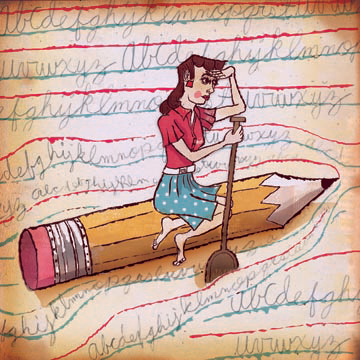It's 6:42 on a Sunday morning in Gainesville, Florida, the sun barely tinting the sky with a faint band of pink and orange from its spot just below the eastern horizon. I'll be boarding a plane in eighteen minutes, returning home to New Hampshire. Around me, fellow travelers stare or doze, some sprawled supine across the molded plastic seats. As for me, I have my laptop out. I'm writing.

I'm a writer. Always have been, ever since I grasped that fat red pencil in Mrs. Gardner's first grade class and carefully copied the alphabet onto yellow paper. I loved the precision of staying right atop the line as I wrote capital A, B, C; the way the small g's tail would reach down and touch the line below, the way the capital S's center curve would slice its space exactly in half. Then I learned that letters marched in order to make words, and words made sentences, which formed paragraphs, and pages, and stories. I was hooked.
I've always heard a voice speaking to me, a narrator deep inside. On an icy winter night when I was six, my mother called me in to dinner. I suddenly dropped down in the snowy field and stared at the star-scattered black sky. A voice said to me, "River of mystery, flowing along ..." Listening, I recognized a poem—three stanzas. I had only to write it down when I got home. That was the beginning.
Through junior high "editorship" of an underground newspaper, through angst-filled high school diary entries, and on to Brown, where I added Brown Daily Herald sports coverage to an already full plate of English papers—I wrote. Easily. Joyfully. Pounding a manual Smith Corona, Wite-Out at hand, I never tired of writing—even when I'd dragged myself back to the dorm after hockey practice followed by a stint flipping burgers until 2 a.m.
As I read for my English major, I learned the craft of writing. The right-brain art, the left-brain structure. The architecture of a story. The beauty of words, alone and in sentences, the way they fit with one another and create a rhythm that can build to a crescendo, or fade to a tuning-fork whisper. I came to value style over story; John Updike could write anything and I'd weep over his perfect prose. Reading my assignments, I felt as if I were gripping raw earth in my hands, joining a group that loved words and knew how to use them. I was becoming a writer.
After Brown, I did the only thing I knew, the only thing I wanted to do: write. For small weekly newspapers where most headlines involved either the zoning board or the high school basketball team. And where the Smith Corona gave way to an Apple. I turned to commercial writing, and for eighteen years have been writing catalogue copy, newsletters, sales pieces: any words my company, King Arthur Flour, needs put in print.
I've turned my hands to blogging now, my fingers rapping out six blogs a week for two different corporations. I blog about baking: about brownies and bread and biscuits, about how to make the ultimate birthday cake. I blog about breast cancer, encouraging my fellow survivors to take hold of their lives. To keep moving forward, past that desperate diagnosis and on to better things, to a good life after cancer. And even now, tapping on my iBook, I feel that same rush I did nearly fifty years ago, when I lay down in a dark winter field and heard a quiet voice tell me a poem. I'm a writer; it's what I am, as much a part of me as my Irish smile and graying hair. I'll never stop—never.
And I guess that's the definition of passion.
P.J. (McKearney) Hamel lives in Lebanon, New Hampshire.





